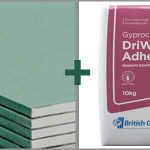If you are looking to give your home a new look, one of the first things to change are your walls. They can be covered in anything from wallpaper or paint, to Artex, woodchip, or old plaster.
Painting can often be simple enough to update. In most cases you can just repaint. However, this is not always the case. Painted walls can be damaged, blown and the paint can even flake away.
This could leave you considering other options such as covering the old surface and restarting from scratch. One option you may look at is boarding over with dot and dab. If you are serious about this option, then you may wonder if it’s possible to use dot and dab on painted walls?
It is possible to dot and dab plasterboard onto a painted wall. However, before you begin the process, you will need to carry out some prep work. Using dot and dab onto paint can come with some potential issues, so you need to identify any problems beforehand.
To achieve a solid bond with the dot and dab, the surface will need to be secure. This is because the dot and dab adhesive will need a solid surface to bond with. If the paint is flaking, blown, or cracked, then you will need to remove the paint. If the paint is in excellent condition, then you should be OK to dot and dab straight on top of it.
How to Prep Painted Walls Before Dot and Dab

There are several ways of approaching this job and that depends on the condition of the walls. When you use dot and dab, you will need to make sure that the substrate is solid. This means that the paint should be in excellent condition.
Therefore, it’s important to make sure that the surface is smooth and still stuck to the wall underneath. Once you complete the check and are confident that the surface is ok, you can begin preparation.
There are several options to pick from here.
- If you are confident that the paint is in prime condition, you can apply the drywall adhesive over the top. This should create a solid bond and hold the plasterboard in place.
- If you feel the need to carry out additional work, you can score the paint using a scutch chisel or another sharp tool. Do this to create light lines in the paint but do not score the paint to the surface below. This will help to create a key for the adhesive to grip to.
- You can apply a weak PVA coat over the top of the paint. This will create a better surface for the adhesive to bond to.
- Depending on the size of the surface, you could scrape away the paint in the areas where you will apply the adhesive. This is easier than removing all the paint. You will then have a solid substrate which could be bare brickwork or exposed plaster to apply the adhesive to. The surface will need to be dust free and you will need to apply PVA. The first coat should be mixed at a ratio of 3:1. Once dry, you can apply the final coat at a ratio of 5:1. Once it becomes tacky, you can then apply the adhesive.
Can You Skim Plaster Over Paint?
You might choose an alternative option to using dot and dab. One option is to skim plaster directly over the paint. This is possible to do, although some prep work is required.
Whatever option you choose, you will need to clean your walls down beforehand. Along with this, you will also need to check the condition of the wall.
Before you start plastering, you will need to create a key. In this instance, you should opt to use blue grit. This is used to provide a strong key to smooth surfaces as it contains a fine grit that the plaster will bond to.
You could also choose to score the paint lightly. Again, this will help to create a key, enabling you to apply the plaster directly on top. However, when using this method and not using something like bluegrit, it is important that you PVA your walls.
To do this, mix the PVA with a ratio of 3:1 (3 parts water and 1 part PVA). You can then roll the mix onto the walls before you leave it to dry. Finally, you can apply another coat before you begin plastering.
The reason for using PVA is to help the plaster grip and bond to the walls. It will also help to reduce the speed of suction which ensures that the plaster dries at a good rate.
If the walls are in a poor condition, then you still have some options.
If the paint is loose or peeling, you will need to deal with the issue. You will need to remove all loose areas and scrape it off until the paint begins to stop coming away. If some patches of paint feel firmly stuck to the wall, you could opt to leave it. However, to be sure, you should remove it completely.
You can choose to use Blue Grit. You will need to roll it onto the walls and once dry, this will help to create a strong key. Once dry, you can then begin to skim.
More Alternatives to Dot and Dab?
Fortunately, there are a few other options available to use. These will depend on your walls, time, and competency.
If you have a stud wall, you could choose to apply plasterboard directly over the painted walls. Providing the walls are level, you will need to find the stud below the existing plasterboard. Once you have done this, you can then offer up the plasterboard and fix them directly on top. To do this, you will need to use plasterboard screws that will go through the existing boards and firmly into the stud wall beneath.
Another option with solid walls, is to fix timber battens to the wall. This will enable you to achieve an excellent finish. The battens and board would have a similar depth as dot and dab + boards.
Should you choose this option while using 1200 x 2400mm boards, you should secure treated timber battens directly to the wall. This should be done at intervals of 400mm. This will help to reduce the need of trimming the width. You should ensure that the board meets the middle of the batten, as this will enable you to fit the next piece on top of the remaining batten.
Conclusion
It is possible to dot and dab on painted walls. However, you will need to ensure that the paint is in excellent condition. If not, you will need to carry out prep work to make sure that the walls are ready to accept the adhesive.
If you feel as though you don’t want to dot and dab, then you also have several other options to choose from, which means that you can achieve the perfect walls that you are looking for.




